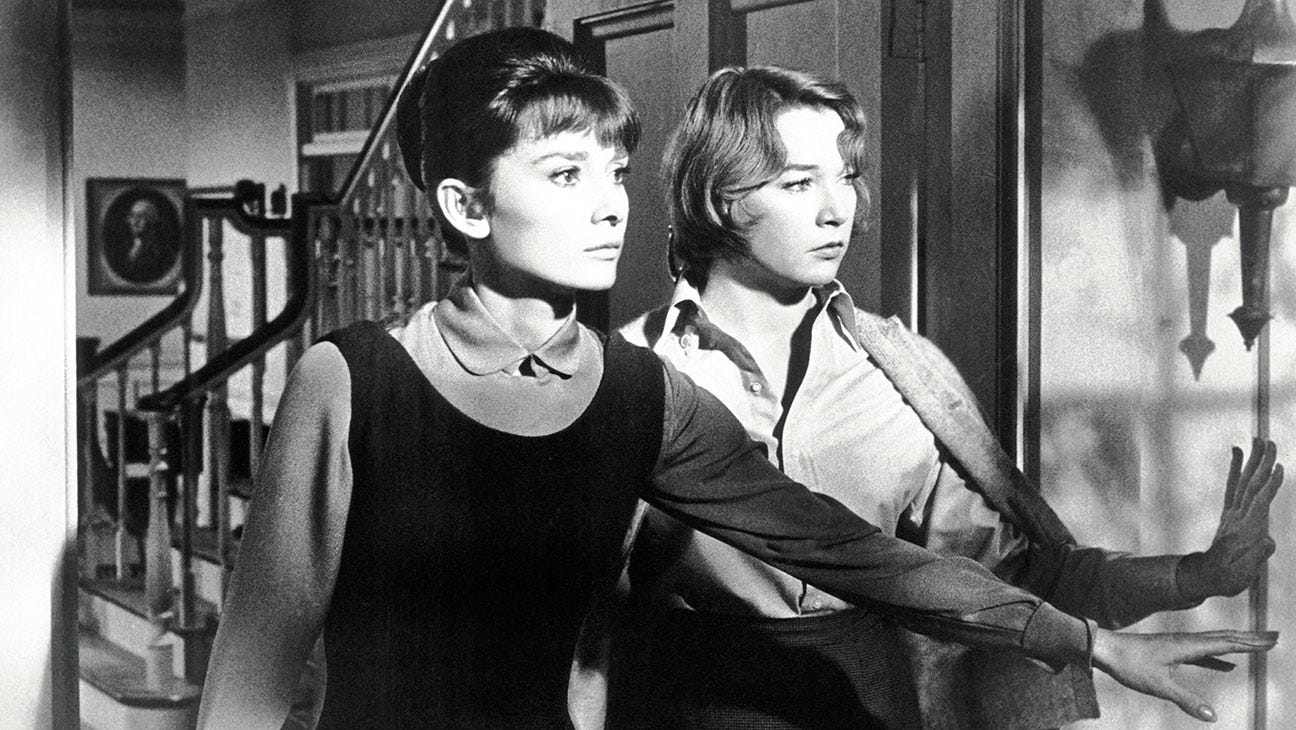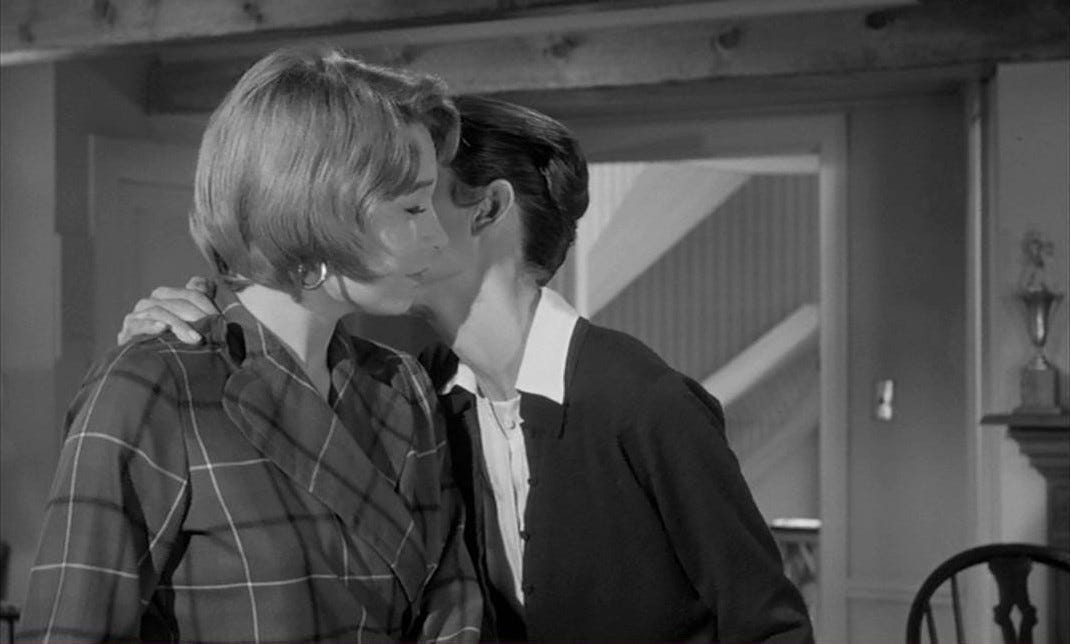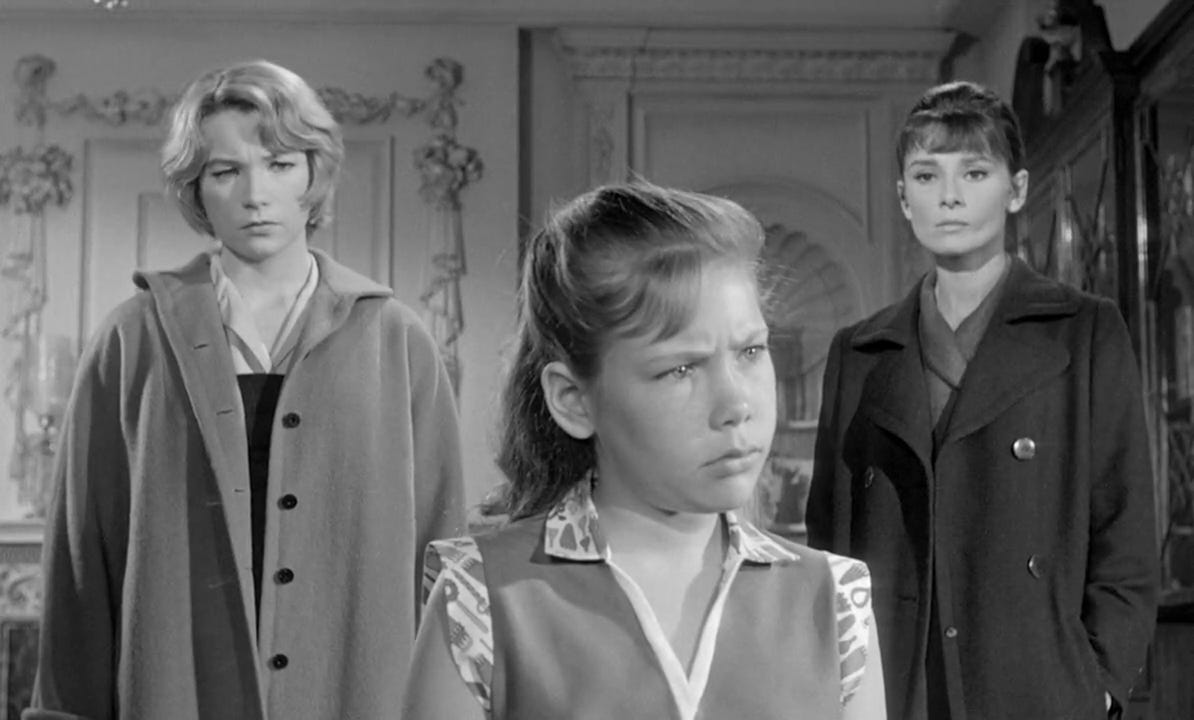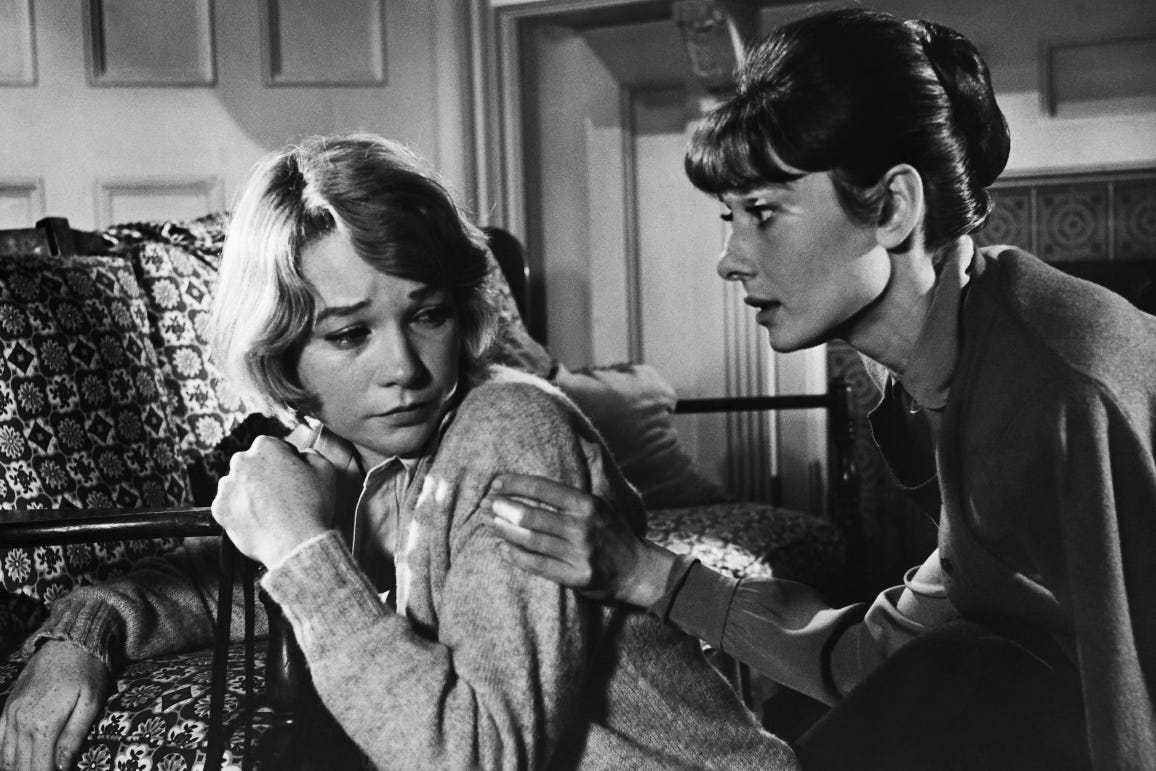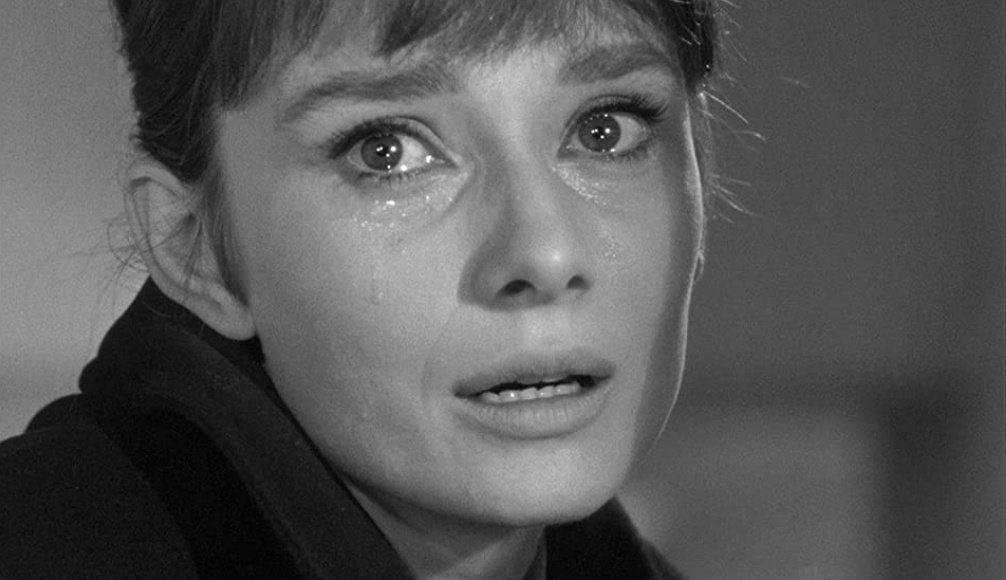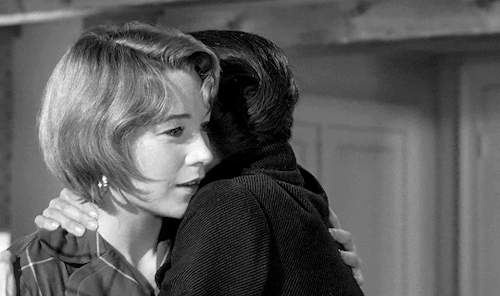Gay Shame and Queer Failure in 'The Children's Hour' (1961)
This is the Sunday Edition of Paging Dr. Lesbian. If you like this type of thing, subscribe, and share it with your friends. Upgrade your subscription for more, including weekly dispatches from the lesbian internet and monthly playlists. You can also buy PDL stickers. A Note: though this film came out over 60 years ago, I do want to warn you that this essay totally spoils the ending. ACT IIt’s an idyllic spring day. Outside, girls are riding their bikes and enjoying the sunshine. Inside, a piano recital. A perfectly lovely Audrey Hepburn smiles at her best friend as they regard the day’s entertainment. An equally lovely Shirley MacLaine flanks the other side of the room, observing the girls’ performance rather than Hepburn’s glowing face. The film is The Children’s Hour, William Wyler’s 1961 adaptation of the play of the same name. Lillian Hellman’s play premiered in 1934, at a time when depictions of homosexuality on stage were still illegal in New York State. The production was a huge success, however, and the matter of (il)legality was overlooked. (The play was later banned in Boston and became the subject of the ACLU’s first gay rights case.) Hellman based the play on the true story of two Scottish teachers accused of engaging in a sexual relationship with one another, a rumor that effectively destroyed their lives. Wyler first took a stab at adapting the play in 1936, and this version was titled These Three. Because of the recently instituted Hays Code – which censored Hollywood films on grounds of morality – any illusions to homosexuality were strictly prohibited. (On the other hand, the original ending of The Children’s Hour aligns with the Hays Code directive that all sin must be punished.) As such, These Three excised the central theme of lesbianism, and the film instead centered on a rumored extra-marital heterosexual affair. Despite these significant changes to the plot, Hellman was supposedly still happy with the film, as it retained the play’s central lesson about the destructive power of gossip. When Wyler returned to the play twenty-five years later, the Hays Code was still in effect, but the hold it had on American filmmaking had lessened significantly. The final nails in the coffin for the code were two 1967 films, Bonnie and Clyde and The Graduate, which proved just how out of date these moral prescriptions had become. Still, 1961 was not yet a time of radicalism, and it would be another eight years before the Stonewall riots posed the question of gay rights as a national issue. Though the threat of lesbianism is a central thread in The Children’s Hour, it is rarely named as such due to the explicit and implicit censorship of the time. The film follows two best friends, Karen (Hepburn) and Martha (MacLaine), who have achieved their dream of opening a school for girls. Everything is going great for the two women until a man comes in and ruins everything. You see, Karen is engaged to a dashing doctor named Joe (James Garner), but has been hesitant to set a date for their wedding. When they finally decide marriage is a sure thing, Karen is overjoyed, but Martha is not. Martha fears Karen will leave her, and reacts with an angry outburst. She apologizes, and Karen immediately forgives her, sealing her goodwill with a kiss on the cheek. Unfortunately for Martha and Karen, they are not alone. Their private conversation is being observed by perhaps the most evil little girl in cinematic history – a conniving autocrat named Mary (Karen Balkin). Mary hates Marth and Karen because they punish her for misbehaving, and her role is that of a horror movie villain. Later, two of Mary’s minions overhear Martha fighting with her Aunt Lily (Miriam Hopkins, who played Martha in These Three). Aunt Lily calls Martha’s attachment to Karen “unnatural,” and claims that Martha has always had strange, jealous relationships with her female friends. Mary is not quite sure what she can do with this information yet, but she knows it’s worth something. Throughout all of this, Martha is desperate and angry, and Karen is miraculously understanding. Though we have no real confirmation that anything Aunt Lily has said is true, Martha’s love for Karen is nonetheless apparent from the very start. Early on in the film Martha describes the first time she saw Karen in college, recalling how pretty she was. Later, Joe interrupts their reminiscing to take Karen on a drive, and Martha takes her evening walk alone. The casting is perfectly suited to this familiar dynamic. Audrey Hepburn, the paragon of white, feminine heterosexual perfection, has a graceful, almost untouchable way about her. Shirley MacLaine, though just as beautiful and talented, is an avatar for a more relatable, oftentimes off-kilter kind of woman, personas she inhabited in unusual films like Sweet Charity (1969) and The Apartment (1960). MacLaine’s characters are often striving for something that appears just out of reach, characters with a rich inner world that others don’t quite understand. In this context, Hepburn and MacLaine are the perfect pairing – one who embodies humble purity, the other longing for love and acceptance. You might be able to guess how this turns out, but then again, things aren’t always as they seem. ACT IIMary is riding in the car with her grandmother, Mrs. Tilford (Fay Bainter), who is also Dr. Joe’s aunt. Armed with potentially damaging gossip about Martha and Karen, Mary has run away from school, only for Mrs. Tilford to deliver her back to the premises. Mary doesn’t want to go back to school, so she tells Mrs. Tilford everything she’s heard about Karen and Martha. Mrs. Tilford remains unbothered until Mary makes up a lie with deadly consequences. We never hear exactly what it is that Mary whispers in her grandmother’s ear – presumably it’s something of a sexual nature, since we saw Mary reading a naughty book earlier in the film – but Mrs. Tilford’s horrified face tells us everything we need to know. Mrs. Tilford storms onto the premises, and Aunt Lily’s exasperated ramblings about her niece’s “insane devotion” to Karen confirm her suspicions. The car turns around and Mary gets her wish – she doesn’t have to return to school. Soon after, all the girls start leaving the school, Mary’s rumor having spread among the parents. As the last girl leaves, Karen finally learns about the rumor that’s damned them both. Karen, Martha, and Joe arrive at Mrs. Tilford’s house to discuss the issue. The first time the rumor is spoken plainly, Karen uses the word “lovers” to describe the alleged relationship. Martha is furious, Karen is confused, and Mrs. Tilford keeps invoking “the children.” Martha rages at Mrs. Tilford, threatening to make her spill the truth in court. Mrs. Tilford is so upset she can’t even name the scandal in question. “This thing is your own. Go away with it, I don’t understand it. I don’t want any part of it, take it out of here,” she declares, echoing the moral guidelines of Hays Code censorship. Karen, for her part, looks devastated. “Wicked very old, wicked very young,” she mutters. Suddenly, Martha’s anger seems to deflate, and Karen takes on the mantle of righteous indignation, her impeccable composer beginning to crack. Mary blackmails Rosalie (Veronica Cartwright) into lying on her behalf, and Martha and Karen are left with no other choice but to take their leave. Though lesbianism is the central (if unspoken) problem of the film, MacLaine admits that she and Hepburn never once discussed it. Speaking in the documentary The Celluloid Closet, MacLaine herself seems shocked that the topic never came up despite its ghostly omnipresence in the script. “The profundity of this subject was not in the lexicon of our rehearsal period,” MacLaine explains. Even Hellman, a Jewish leftist who also penned the script for These Three, seemed comfortable with the assumption that the play is primarily about how gossip destroys lives, not homophobia. But, although this queer throughline remained unspoken, both MacLaine and Hepburn give grounded, ultimately truthful performances, imbuing the characters with strength and thoughtful transparency. As we will see in the third act, any emotional resonances the film has rests on the audience's ability to feel with and for these women, and in that regard it is a rousing success. ACT IIIThe final act of The Children’s Hour mirrors its opening. The camera scans the school’s exterior, except this time, it’s a blustery fall day, not a cheerful spring one. More importantly, the school is totally empty, save for its two remaining residents. Martha and Karen have lost the suit, though we know little of what’s happened apart from the judge’s conclusion that they’ve had “sinful sexual knowledge” of one another (the most forthright explanation of the accusation we’ve heard thus far). The whole town knows, which means they’re pariahs and can’t leave the house. Joe proposes that the three of them leave town and start anew, but Karen rejects his proposal because she’s not sure if he believes the rumors or not. She turns him away graciously, proving once again that she’s the most understanding woman in the world. Instead, Karen suggests that she and Martha run away together. Martha protests that their newfound infamy would make this impossible. “But this isn't a new sin they say we've done. Other people haven't been destroyed by it,” Karen says, in what is the film’s clearest allusion to the material existence of gay people outside of these walls. Martha argues that those are people who've chosen that life for themselves, which she and Karen have not. Martha then does something rather unexpected, resulting in by far the most moving scene in the film: she comes out. She begins by trying to rationalize her closeness with Karen until she can no longer deny it anymore. Karen is confused until Martha literally screams the truth at her. “Listen to me!” she yells, and Karen whips her head around. “I have loved you the way they’ve said!” Karen looks shocked, while Martha sobs into her hands. Martha describes how she’s always felt there is something wrong with her, and she can’t keep it in any longer. “I’m guilty!” Martha exclaims. “You’re guilty of nothing!” Karen fires back. But Karen doesn’t quite understand, not yet, and she doesn’t want to believe it. The shame Martha feels is so piercing, so deep, she can hardly stand to live. She doesn’t want Karen to touch her, or to look at her. “I feel so damn sick and dirty, I can't stand it anymore!” she cries out. Karen, who has begun to comprehend that Martha is not making this up, looks deeply saddened by her friend's pain. Her face is one of utter sympathy, if not empathy. She may not understand what Martha feels – though perhaps she appreciates the issue more than she lets on – but she never turns her back on her. In her book Feeling Backward, Heather Love writes that “Queer history is, in a sense, nothing but wounded attachments.” Love argues that although contemporary gay rights discourse posits pride as the goal of social progress, it is the history of shame that undergirds this forward-thinking orientation. Lesbian abjection and gay shame are constituted as perverse, “bad” feelings that should be stamped out at all costs. “Celebration will only get us so far, for pride itself can be toxic when it is sealed off from the shame that nurtured it,” Love warns. Martha is a woman whose conscience is made up of shame, and this makes her a figure seemingly unworthy of sympathetic consideration. Martha may not be a “positive” queer character, but her experiences are quite real, despite what MacLaine has said about the obliviousness with which they approached her perspective. She is ruined, abjected, and has failed to embody queer joy, but it would be a mistake to turn away from her pain. Shortly after Martha’s confession, there’s a knock on the door. It’s Mrs. Tilford, who’s just learned the truth – Mary made it all up and forced Rosalie to corroborate her story. There will soon be a retraction in the paper. Mrs. Tilford wants Karen and Martha’s forgiveness, but they will not give it to her. Karen, who has just seen what the rumor has done to her best friend, is especially dismissive of Mrs. Tilford’s delinquent apology. The passionate anger that once possessed Martha has now been drained from her body – she’s lost the will to fight. Despite Martha’s shocking declaration, Karen still wants to run away with her, and attempts to cheer Martha up with the prospect of better days ahead. It’s too late. The ending of The Children’s Hour is well-suited to the rules of the Hays Code, which requires harsh consequences for sinful behavior. Karen leaves Martha in her room as she goes for a walk, but soon afterward senses something is wrong. She runs back into the house and finds that Martha’s door is locked, and there’s no doubt in her mind what’s happened. She uses all her force to break down the door, and finds Martha hanging from a rope on the ceiling. (We never actually see Martha, only the shadow of a rope and the shadow of a pair of feet, swaying against the white bedspread). Karen’s entire face shakes, and then crumples, as she falls to the floor in despair. It may be the most disheveled Audrey Hepburn has ever looked, and she plays the scene as if she’s in a grisly Hitchcock picture. “Oh, Martha,” is all she can say. (In the play, Martha commits suicide before Mrs. Tillman’s arrival. It’s hard to say what’s more tragic – Martha taking her life before the public apology, or being so despondent she does it after.) We then cut to the funeral, where Karen is standing alone at Martha’s coffin, reading a passage from the Bible. Only Aunt Lily stands nearby – the other attendees look on from the cemetery’s entrance. “I’ll miss you with all my heart,” Karen whispers before walking off. She strides past the onlookers with her head held high, ignoring Joe as if he never mattered to her at all. In the last few seconds of the film, she looks up at the trees, a faint smile on her face. The music rises in a pleasant crescendo, as if this might be a happy ending, after all. Is Karen possessed by Martha’s now-dashed hope for a better life? Will she carry the torch for her best friend, so to speak? Has Martha finally been released from her suffering? The meaning of Karen’s determined walk is up for interpretation, but one thing’s for certain: Karen loves her best friend. She never abandoned her when things got tough, and she will not abandon her in death either. Martha lives on through Karen’s memory of her, and Karen is nothing if not a vigilant friend. EPILOGUEKaren walks off to start a new life. Or, she walks off to live the life Martha never could. Or, she journeys to find those nameless others, those strange souls who have been accused of sin but have not had their lives destroyed by it, because they have chosen it for themselves. Or… The Children’s Hour is a story of queer failure. Martha has failed to live a happy, proud queer life which seems to be the end goal in the contemporary gay imaginary. But the film itself has also been seen as a failure. “We didn’t do the picture right,” MacLaine maintains. “These days there would be a tremendous outcry, as well there should be,” she says of Martha’s refusal to stand up and fight back. MacLaine is right that the film doesn’t ‘fit’ within modern queer discourse. As Love writes, these two modes of being are positioned as polar opposites. “Contemporary gay identity is produced out of the twentieth-century history of queer abjection: gay pride is a reverse or mirror image of gay shame, produced precisely against the realities it means to remedy.” In the end, what’s most interesting about The Children’s Hour is how it depicts abjection but does not condemn those who are made abject. You can feel censorship in every frame of the film. Some of this is embedded in Hellman’s source material, which though it depicts the tragedy of lesbian suffering, stops short of defining a clear lesbian subjectivity. The language of the film is often vague, giving audiences a sliver of plausible deniability concerning what the film is really about. Indeed, MacLaine has said that Wyler cut several scenes in the film that depicted intimate moments such as Martha brushing Karen’s hair, scenes that might have hinted that something else was going on behind closed doors. Most damningly, the revelation of homosexuality is so horrible that Martha’s only option is death. And yet……Though the whole world may judge Martha, Karen does not. Moreover, while the film’s conclusion contains a homophobic message, the audience is pushed towards sympathy for Martha, rather than disdain. The film may kill her, but the viewer is never instructed to turn against her. Her story is undoubtedly tragic, but in a way that inspires actual grief, not simply dramatic indulgence. Martha is important to Karen, she is important to the film, and thus is important to the viewer. As Karen proudly walks by the dismal funeral procession, she keeps Martha’s memory close to her heart. An optimistic viewer might imagine that Karen is walking with Martha into a heretofore unseen queer future. It’s not much of a leap to hypothesize that Karen is a little queer herself – she dropped Joe in favor of Martha very quickly, if you recall. But whether Karen returns Martha’s affections or not, it’s clear Karen’s devotion to Martha has given her a new sense of determination and strength. Karen no longer cares about living the life that’s expected of her, even though a handsome doctor is begging for her hand. Regardless of Karen’s own queer (or not) afflictions, this is a very queer move to make, walking off into a new life entirely of her own making. With her memory now under Karen’s loving protection, no one can hurt Martha anymore, not even Martha herself. Is this why Karen is perversely happy, there at the end? Martha finally gets her flowers, even if Karen is the only one left to collect them. You’re a free subscriber to Paging Dr. Lesbian. For the full experience, which includes weekly dispatches from the lesbian internet, become a paying subscriber. Your support means a lot! |
Older messages
The Top Eight Mission: Impossible 7 Scenes for People Who Love Hot Women
Sunday, July 16, 2023
•Saoirse Ronan Voice•
What's In A (Lesbian) Word?
Sunday, July 9, 2023
On The L Word and Other Queer Phrases
What Is Lesbian Fashion?
Sunday, July 2, 2023
A chat with Eleanor Medhurst, the creator of Dressing Dykes
Bodies Ablaze
Sunday, June 25, 2023
Mrs. S is a New Kind of Queer Romance Novel
Let's Go Team
Friday, June 23, 2023
🏳️🌈 ✉️❤️
You Might Also Like
Painting Snakes
Thursday, March 6, 2025
Slice-of-life comics by Edith Zimmerman. ͏ ͏ ͏ ͏ ͏ ͏ ͏ ͏ ͏ ͏ ͏ ͏ ͏ ͏ ͏ ͏ ͏ ͏ ͏ ͏ ͏ ͏ ͏ ͏ ͏ ͏ ͏ ͏ ͏ ͏ ͏ ͏ ͏ ͏ ͏ ͏ ͏ ͏ ͏ ͏ ͏ ͏ ͏ ͏ ͏ ͏ ͏ ͏ ͏ ͏ ͏ ͏ ͏ ͏ ͏ ͏ ͏ ͏ ͏ ͏ ͏ ͏ ͏ ͏ ͏ ͏ ͏ ͏ ͏ ͏ ͏ ͏ ͏ ͏ ͏ ͏ ͏ ͏ ͏ ͏
Everything You Need to Start Building Muscle at Home
Thursday, March 6, 2025
Everything you need to know to get started with your new workout routine. View in Browser Men's Health The Best Gear to Start Weight Training The great flaw of home gym-building is thinking you
More On Urbanism and Natalism
Thursday, March 6, 2025
"Cities depress fertility" is not a metaphysical truth ͏ ͏ ͏ ͏ ͏ ͏ ͏ ͏ ͏ ͏ ͏ ͏ ͏ ͏ ͏ ͏ ͏ ͏ ͏ ͏ ͏ ͏ ͏ ͏ ͏ ͏ ͏ ͏ ͏ ͏ ͏ ͏ ͏ ͏ ͏ ͏ ͏ ͏ ͏ ͏ ͏ ͏ ͏ ͏ ͏ ͏ ͏ ͏ ͏ ͏ ͏ ͏ ͏ ͏ ͏ ͏ ͏ ͏ ͏ ͏ ͏ ͏ ͏ ͏ ͏ ͏ ͏ ͏
Women in Sign Painting: Burds of the Brush
Thursday, March 6, 2025
Rachel E Millar shares her and her guests' reflections on the first Burds of the Brush in Glasgow. BLAG Magazine: Adventures in Sign Painting Craft, Community & Culture Women in Sign Painting:
How to Win the Message War on Tariffs
Thursday, March 6, 2025
Trump decision to raise prices on every American is major vulnerability ͏ ͏ ͏ ͏ ͏ ͏ ͏ ͏ ͏ ͏ ͏ ͏ ͏ ͏ ͏ ͏ ͏ ͏ ͏ ͏ ͏ ͏ ͏ ͏ ͏ ͏ ͏ ͏ ͏ ͏ ͏ ͏ ͏ ͏ ͏ ͏ ͏ ͏ ͏ ͏ ͏ ͏ ͏ ͏ ͏ ͏ ͏ ͏ ͏ ͏ ͏ ͏ ͏ ͏ ͏ ͏ ͏ ͏ ͏ ͏ ͏ ͏ ͏ ͏ ͏
“A Beautiful House with a Hot Tub and Pool” by Jason Schneiderman
Thursday, March 6, 2025
I miss my magnolias, miss my maples, think ͏ ͏ ͏ ͏ ͏ ͏ ͏ ͏ ͏ ͏ ͏ ͏ ͏ ͏ ͏ ͏ ͏ ͏ ͏ ͏ ͏ ͏ ͏ ͏ ͏ ͏ ͏ ͏ ͏ ͏ ͏ ͏ ͏ ͏ ͏ ͏ ͏ ͏ ͏ ͏
Bring us a glass of milk for this dupe
Thursday, March 6, 2025
— Check out what we Skimm'd for you today March 6, 2025 Subscribe Read in browser Together with Alfa Romeo But first: experience Italian luxury every day Update location or View forecast Quote of
Meghan Markle Nailed The Easy Spring Outfit Of Our Dreams
Thursday, March 6, 2025
She met up with Serena Williams for a casual lunch date. The Zoe Report Daily The Zoe Report 3.5.2025 Meghan Markle Nailed The Easy Spring Outfit Of Our Dreams (Celebrity) Meghan Markle Nailed The Easy
What I Learned From a 30-Minute Recomp Workout
Wednesday, March 5, 2025
View in Browser Men's Health SHOP MVP EXCLUSIVES SUBSCRIBE What I Learned From a 30-Minute Recomp Workout What I Learned From a 30-Minute Recomp Workout Dr. Pat Davidson's 'Double-Deuce
What People Are Getting Wrong: Measles Myths
Wednesday, March 5, 2025
3 Roth IRA Rules to Know During Tax Season. It turns out that hosting "measles parties" is a bad idea. Not displaying correctly? View this newsletter online. TODAY'S FEATURED STORY What

